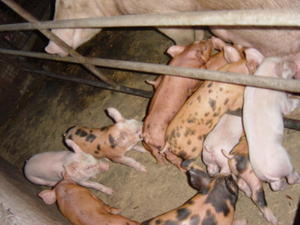We all do it. We all indulge in a nice steak, pork ribs or chicken a few times a week. The truth is, we consume way more meat than we need to survive. Domestic hog production in Canada reached 23.8 million head, compared to the 14 million it was in 1990 and it's rising. This is not only leading to an extremely unhealthy lifestyle, but also pushing the demand for meat higher than it's ever been, and in turn, pressuring the meat industry to focus more on quantity rather than quality.
Factory farming should be something that each of us think of when taking a bite out of that steak, but the reality is that most people are buying their meat without really knowing where it came from or what happened to it before it was slaughtered, packaged and placed on our dinner tables. The disgusting treatment of animals is sure to abolish your appetite at first glance at a documentary on any of these factories. People rarely think of cows or pigs as anything but beef and pork. We treat them as if they're already dead and being served. And if it is so hard for you to feel anything for your food before it is killed, then ask yourself this: wouldn't the meat taste better if it was treated better? Wouldn't you enjoy it more if it enjoyed its life more? I'm not talking luxury, but I think that "acceptable living conditions" should be at least what we provide. We domesticated these animals, thereby fully accepting the responsibility of having them depend on us. It`s about time we return to our values and treat these animals with a bit of decency before we slaughter them for food that we don`t really even need.
the purpose of power is to protect
- Sant Darshan Singh

Let`s start with pigs. The state that pigs are kept in require them to be left in almost complete darkness simply to keep them calm. They are kept in extremely small pens (see above) that have slits in the floor to allow the waste to fall through, therefore leaving them to lay in the smell, bacteria, and whatever doesn't fall through. When they are standing up for long periods of time, they suffer from foot injuries due to the uneven floor. They spend long periods of time in their pens (form the time that they get to the farm to the time they leave; usually 3-6 months) so because they are kept in complete darkness while they are there, factors like leaving their pens for the first time and being exposed to light causes them to suffer severe panic attacks when being transported to the slaughter houses. Pigs are bad travelers that are very sensitive to stress and can get sick very easily on the road (impacting the quality of your meat).

When they have youngsters, sows (females) are jammed between two rails, so that they cannot turn around and take care of the piglets, only feed them. This is done to prevent the sow from crushing a piglet to death, because of the lack of space. The piglets are brought to the weaning section after the nursing period of 3 to 4 weeks (instead of the natural 14 weeks). At the age of about 72 days they go to the fattening farm, where 14 of them are put in a pen usually on a grid floor without straw.
The males are castrated without anesthetics to satisfy the foreign market, because of the alleged influence of male hormones on the scent of the meat. Sows suffer from severe stress (e.g. heart- and stomach symptoms) because of the limitation of freedom of movement. Out of frustration, the boars usually chew the rails of their cage for long periods of time leading to even more health problems. Pigs are said to have intelligence equal to dogs, I wonder why we don`t appreciate this. Or maybe we superficially classify their value by how physically attractive they are.

These are only a few of the many problems and poor conditions of farming pigs. To read more, visit:

About 2,000 pounds of grains must be supplied to livestock in order to produce enough meat and other livestock products to support a person for a year, whereas 400 pounds of grain eaten directly will support a person for a year. Thus, a given quantity of grain eaten directly will feed 5 times as many people as it will if it is eaten indirectly by humans in the form of livestock products.


I am no one to say that eating meat is wrong. The natives used to hunt to provide for their families and their communities. It was an important part of their culture. They lived off the land and made sure no part of the animal went ot waste. But what we have done to `hunting` and meat consumption is anything but natural. We have made a mockery out of what used to be acceptable. This is something that needs to change both for the rights of these animals and for the sake of our pride.
Learn the truth about the meat industries. Don`t eat blindly.
http://www.youtube.com/watch?v=IFXi6MjKw-0
Warning: very graphic
No comments:
Post a Comment